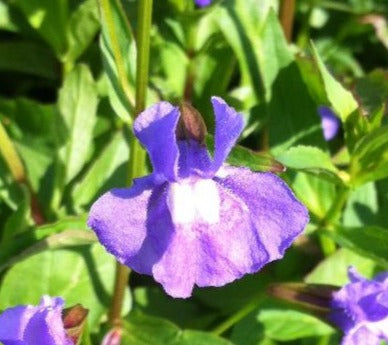1
/
of
1
MIMULUS RINGENS / MONKEY FLOWER
- Regular price
-
$19.95 CAD - Regular price
-
- Sale price
-
$19.95 CAD
Shipping calculated at checkout.
Couldn't load pickup availability
Delivery Fees
Delivery Policy
Enjoy FREE delivery on all orders over $149!
For orders between $80 and $149, a $18.99 delivery fee will apply.
Orders under $80 will be prompted to add more items to your cart.
- Botanical Description: Mimulus ringens is a perennial herb that belongs to the family Phrymaceae. The plant typically grows in wetland habitats, such as marshes, meadows, and along stream banks. It has square stems and opposite leaves. The leaves are serrated and lance-shaped.
- Flowers: The flowers of Mimulus ringens are distinctive and tubular, resembling the face of a monkey, which is the origin of the common name "monkey flower". The flowers have two lips, with the lower lip often having prominent spots or markings. The color of the flowers can vary, but they are commonly lavender to blue-purple.
- Ecological Role: Monkey flower plays a significant ecological role in wetland ecosystems. It attracts pollinators such as bees and butterflies with its nectar-filled flowers. The plant is adapted to thrive in moist conditions and helps stabilize soil in wetland areas.
- Cultural Significance: Some Native American tribes historically used Mimulus ringens for medicinal purposes. For example, the Ojibwa people reportedly used it to treat various ailments.
- Gardening and Landscaping: Monkey flower can be cultivated in gardens, particularly in areas with moist or wet soil. It is a good choice for rain gardens or other landscaping projects focused on water-loving plants. Gardeners may appreciate the unique appearance of the flowers and the plant's ability to attract pollinators.
- SPREAD 40-50 CM
- HEIGHT 70-85 CM
- PLANT ZONE 3
- NATIVE TO ONTARIO
Care Instructions
Different plants have different watering needs. Check the soil moisture by inserting your finger about an inch into the soil. If it feels dry, water the plant until the water drains from the bottom of the pot. Avoid overwatering, as it can lead to root rot.


MIMULUS RINGENS / MONKEY FLOWER
- Regular price
-
$19.95 CAD - Regular price
-
- Sale price
-
$19.95 CAD
SALE
All Echinacea & Monarda, Buy 4 get 1 Free! No code required


